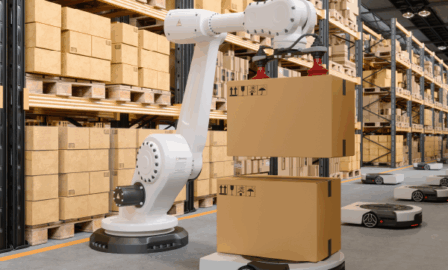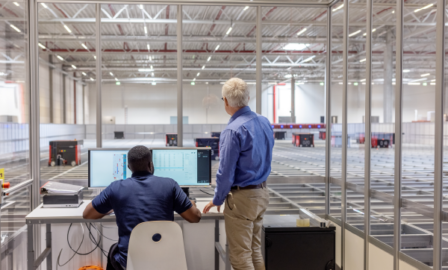Getting Started with Supply Chain AI
Ten years ago, the thought of having a conversation with a computer was only a possibility in science fiction movies, however, today it has become a normal everyday occurrence. From customer service chatbots to the personal assistants in our cell phones and homes to the evolution of self-driving cars, the use of AI has become just as common as watching movies on Blue Ray Discs or using an iPhone 3 was in 2014.
Today, the ways in which AI will be involved in our daily lives are only beginning to be identified. It is unmistakable – this technology will continue to be employed in both our personal and professional worlds. Supply chains are seeing significant benefits with the usage of AI in areas such as logistics, inventory management, demand planning, as well as in operations and strategic sourcing. Our hope is you can leverage this article in your supply chain AI journey and business strategy decisions, as there are a variety of ways AI can be leveraged depending on the maturity and needs of your business.
What is AI? Narrow AI vs. General AI
Technically speaking, the dictionary defines artificial intelligence (AI) as the ability of a digital computer to perform tasks that historically required human intelligence. The most prevalent areas we have seen AI today has been in digital applications such a Siri, Alexa, ChatGPT, and Google’s Gemini, as well as recommendations that come up on Netflix, Prime Video, Instagram, and Facebook. This type of AI is known as Narrow Artificial Intelligence, meaning that it is built around its programming capabilities.
Another type of AI continues to remain elusive, and it’s known as General Artificial Intelligence (GAI). GAI, while making progress, is more complex, as it expects the computer to simulate intelligence more like a human. This requires the GAI to handle complex problem solving to tailor-make a solution that considers human-like emotion like creativity and empathy. The challenge GAI has is being able to process these diverse answers, perceptions, languages, and connections to come up with the correct decision in a split second. After all, this is what makes the human brain so unique.
For the balance of discussion, we will be referring to Narrow Artificial Intelligence as it can be used to improve your supply chains analysis and decision-making capabilities. If you’re interested in learning more about both NAI and GAI, what is happening today, and some use cases, please follow this link.
Where to Start with Supply Chain AI
In the supply chain, areas where AI has shown its value include demand modeling, inventory optimization, planning and real-time transportation routes and adjustments, supply chain visibility, and recommendations for alleviating potential risks. AI can be further targeted towards specific functions and/or stages throughout the broader network by bridging connections between various organizations creating an integrated supply chain network.
As a company decides to move forward with an AI implementation, it is important to assess the current state of the organization’s maturity. This should not only be a review of its technological maturity, but also of its data and process maturity. Once the assessment is completed and the gaps have been identified, a roadmap of where the organization wants to be, along with the timeline to achieve this, should be identified alongside plans on how to close the gaps.
It is also important to ensure clear business ownership is identified. A robust business case should be developed and approved to ensure business buy-in and agreement on the objectives and cost for each phase of the AI journey, in addition to clear, measurable goals and a defined change management plan. Last, it is important to recognize this is a continuous journey and will never be completely finished. However, leveraging a crawl, walk, run, and fly approach (as shown below) will help the team to feel that they are making progress.
Areas for Consideration
If your organization is just starting with supply chain AI, here is a list of areas that can be low-cost, quick to implement, and help you achieve meaningful improvements. Additionally, focusing on one or two select areas will help with resource management.
Demand Forecasting
For organizations currently using an ERP or technology-based demand forecasting system, the ability to integrate AI and machine learning models into your process is a fairly easy add. The information that can be used includes historical sales data, trends, seasonality, and other relevant factors. This can then be leveraged by AI and ML to perform analysis which can help in predicting future demand patterns with a high level of accuracy. Furthermore, it can support ongoing and real-time analysis, feedback, and recommendations to allow for quicker visibility and notification of changes in customer behavior and market predictions. By having this information, organizations can increase the reliability of demand and supply plans as well as support a more rapid alignment of production and procurement activities to customer demand.
Inventory Optimization
Inventory is an area that companies are always seeking to improve as it has a significant impact on a company’s profitability. The use of AI can make a significant impact in determining optimal inventory levels to ensure availability of stock without excess. AI can calculate changes, projections, and variability of carrying costs, lead time adherence and changes, demand variability, lot size, re-order points, along with service levels. Each of these variables, along with many others, can be used by AI to minimize overstock situations and stockouts while helping to maintain enough stock to meet demand while balancing costs.
Logistics and Route Optimization
Knowing where freight is and when it will be delivered has been a significant area of opportunity for supply chains leaders. With the advancements in AI, organizations can gather data elements having an impact on delivery time and support improved visibility of delays or other areas that could impact timely delivery. AI can be also linked with a logistic providers system or with truck, trailer, and/or container systems, alongside various other types of relative logistics data.
For companies that leverage route delivery, the use of AI can improve delivery performance. It can be used to determine the most efficient routes by considering relevant factors such as traffic patterns, weather conditions, delivery windows, vehicle capacity, and road restrictions. AI can also be used to adjust these routes in real-time based on changing traffic conditions, such as traffic congestion, to ensure timely deliveries.
Advanced Areas for Consideration
As organizations mature in their use of supply chain AI, there are various areas of expansion to consider. These could be focused on integrating with key suppliers, leveraging supply planning tools to create planning scenarios, using Robotic Process Automation (RPA) software to automate repetitive rule-based tasks traditionally performed by humans, or incorporating AI with the use of Internet of Things (IoT) devices. While these areas are much more advanced, it is important to plan and strategize for future events to minimize risk.
As your organization begins to implement cross-functional AI enhancements that integrate data from multiple functions and companies, it is essential to identify from the beginning the functionality and use cases that the organization is interested in achieving.
For help getting started, contact our experts today.
Subscribe to Clarkston's Insights
Contributions by Vanessa Gil



